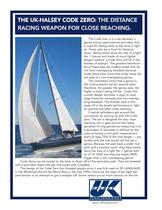
Catalog excerpts

THE UK-HALSEY CODE ZERO: THE DISTANCE RACING WEAPON FOR CLOSE REACHING. The Code Zero is a cross between a genoa and an asymmetrical spinnaker that is used for sailing close to the wind in light air. These sails are a must for distance races. Being nearly twice the size of a light No. 1 Genoa and made of much lighter weight material, a Code Zero will fill in the faintest of zephyrs. The greatest beneficiar- ies of these sails are modern boats that do not have overlapping headsails because Code Zeros have more than three times the sail area of a non-overlapping genoa. The rulemakers know that a genoa is the most powerful sail for upwind work; therefore, the greater the genoa area, the higher a boat's rating will be. Under the current design formulas, it pays to have large fractional mainsails and non-overlap- ping headsails. The Achilles heel in this trade off is the boat's performance in light air upwind and when close reaching. Creative sailmakers got around this conundrum by coming up with the Code Zero. The sail is designed for very close reaching, but it gets around the rating penalties for big genoas by measuring in as a spinnaker. A spinnaker is defined by the rules as having a mid girth measurement that's at least 75% of the foot length — any smaller and the rule would call the sail a genoa. Because the sails have a wider mid girth and a positive roach, they have nearly twice the area of a light No. 1 genoa with bigger than a non overlapping genoa. Code Zeros can be tacked to the bow, or flown off of the spinnaker pole. They are sheeted with a spinnaker sheet and get fine tuned with a tweaker. The design of the Code Zero has changed greatly since it was first used on EF LANGUAGE in the Whitbread Round the World Race in the late 1990s. Gone are the days of bar tight hal- yard tension in an attempt to get a straight luff. (Some sailors put so much tension on the hal-
Open the catalog to page 1
yard that they broke their masts, which were not designed for the forward loads.) Instead, Code Zero designs today have luff round that gives the sail a wider wind range and makes them easier to trim. With luff round (roach on the leading edge), the sail has a flatter entry when the halyard is eased. When reaching you can tighten the halyard to make the luff round curl into a knuckle in the front of the sail, which makes the sail more powerful. The picture at the top right illustrates the Code Zero in reaching mode with a knuckle toward the luff. Modern Code Zeros can be used from 40°-120°...
Open the catalog to page 2
The spinnaker sheet just needs to be worked as a normal spinnaker sheet, but when trimming the sail less movement is better then excessive trimming. This keeps the sail more stable and develops more power. When in full upwind mode, the halyard needs to be taken back on, until it's tight. Normally setting the tweaker at half height to the clew of the Code Zero, about a 45 degree sheet angle is needed for full upwind mode, this angle helps pass the sheet load up the leech of the sail, keeping it more stable. Most Code Zeros will start to curl in at this point, the trick to this is easing the...
Open the catalog to page 3
When the Code Zero is sheeted in tight, steer just as you would with a genoa — sail to the the tell tales. When the boat slows, fall off slightly until the boatspeed builds to about one knot above the wind speed. The highest these sails can be car- ried is 40 - 45 degrees apparent wind angle, but the boat will be a lot faster at slightly wider wind angles. TRIMMING TIPS Upwind Settings (wind angle 40-45° apparent): Tack line tight, tweaker on so that the angle of the spinnaker sheet off the deck is 45°. Once the sail is drawing, ease the halyard down until the luff load eases enough to...
Open the catalog to page 4All UK-Halsey International catalogs and brochures
-
Tape-Drive
4 Pages
-
Cruising Mainsails
2 Pages
-
RACING MAINSAIL
4 Pages
-
TAPE DRIVE
4 Pages
-
Uni-Titanium
4 Pages
-
Titanium
2 Pages
-
X-Drive
4 Pages
-
Matrix Titanium Brochure
4 Pages
-
Passagemaker Brochure
2 Pages
-
SYMETRICAL SPINNAKERS
2 Pages
-
Asymetrical sail spinnakers
2 Pages













